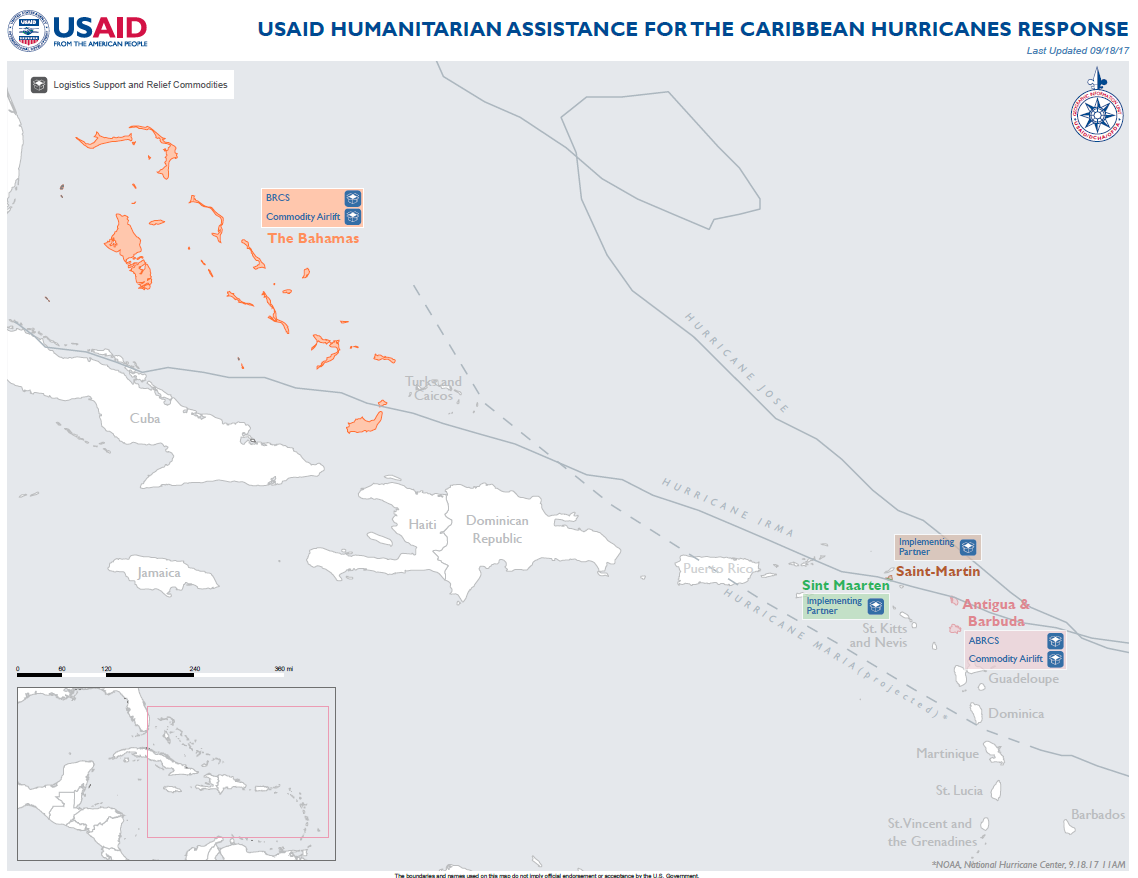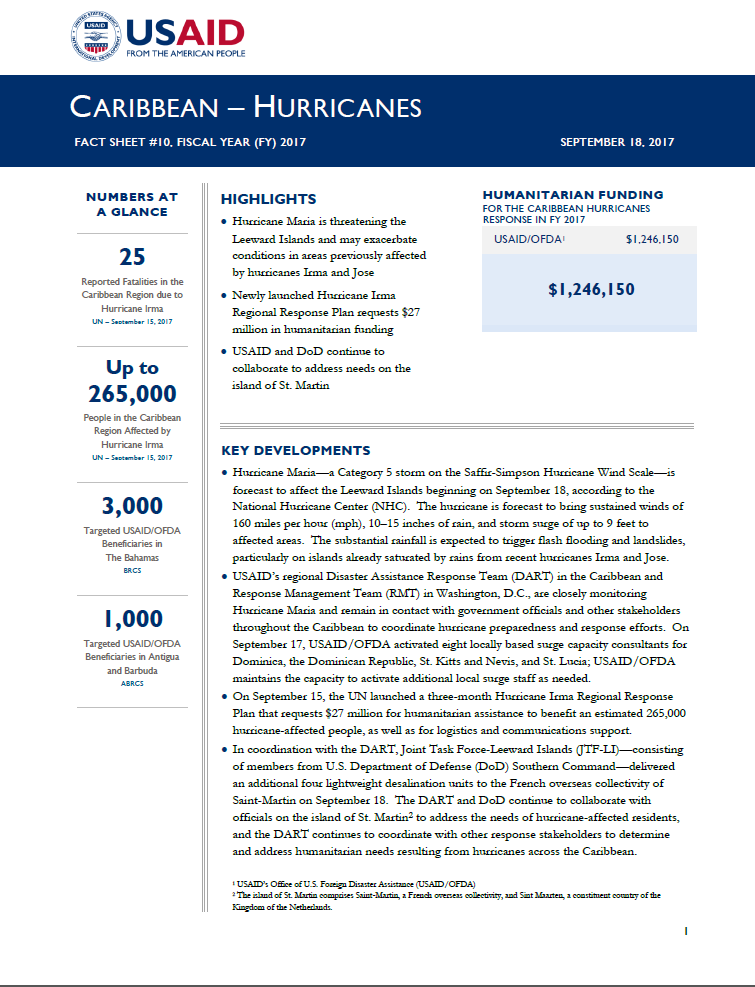September 18, 2017
Highlights
- Hurricane Maria is threatening the Leeward Islands and may exacerbate conditions in areas previously affected by hurricanes Irma and Jose.
- Newly launched Hurricane Irma Regional Response Plan requests $27 million in humanitarian funding.
- USAID and DoD continue to collaborate to address needs on the island of St. Martin.
Key Developments
Hurricane Maria—a Category 5 storm on the Saffir-Simpson Hurricane Wind Scale—is forecast to affect the Leeward Islands beginning on September 18, according to the National Hurricane Center (NHC). The hurricane is forecast to bring sustained winds of 160 miles per hour (mph), 10–15 inches of rain, and storm surge of up to 9 feet to affected areas. The substantial rainfall is expected to trigger flash flooding and landslides, particularly on islands already saturated by rains from recent hurricanes Irma and Jose.
USAID’s regional Disaster Assistance Response Team (DART) in the Caribbean and Response Management Team (RMT) in Washington, D.C., are closely monitoring Hurricane Maria and remain in contact with government officials and other stakeholders throughout the Caribbean to coordinate hurricane preparedness and response efforts. On September 17, USAID/OFDA activated eight locally based surge capacity consultants for Dominica, the Dominican Republic, St. Kitts and Nevis, and St. Lucia; USAID/OFDA maintains the capacity to activate additional local surge staff as needed.
On September 15, the UN launched a three-month Hurricane Irma Regional Response Plan that requests $27 million for humanitarian assistance to benefit an estimated 265,000 hurricane-affected people, as well as for logistics and communications support.
In coordination with the DART, Joint Task Force-Leeward Islands (JTF-LI)—consisting of members from U.S. Department of Defense (DoD) Southern Command—delivered an additional four lightweight desalination units to the French overseas collectivity of Saint-Martin on September 18. The DART and DoD continue to collaborate with officials on the island of St. Martin2 to address the needs of hurricane-affected residents, and the DART continues to coordinate with other response stakeholders to determine and address humanitarian needs resulting from hurricanes across the Caribbean.
Caribbean Hurricanes - Map #10 ![]() (pdf - 258k)
(pdf - 258k)
Numbers At A Glance
25
Up to 265,000
3,000
1,000
Humanitarian Funding
For the Caribbean Hurricanes in FY 2017
| USAID/OFDA | $1,246,150 |
Caribbean Hurricanes - Fact Sheet #10 ![]() (pdf - 190k)
(pdf - 190k)
ANTIGUA AND BARBUDA
In preparation for Hurricane Maria, the GoAB ordered the closure of all public schools across the two islands on September 18, according to local media.
As of September 17, the Government of Antigua and Barbuda (GoAB) National Office of Disaster Services had established a distribution center at the Multi-Purpose Cultural and Exhibition Center on Antigua where Barbudan evacuees sheltering with host families are able to obtain food, water, clothing, and other relief items, according to DART staff on Antigua. An estimated 1,400 Barbudan evacuees are sheltering on Antigua, and most are staying with host community members rather than in formal shelters. Basic public services remain unavailable on Barbuda, where Hurricane Irma destroyed nearly all infrastructure.
The GoAB Ministry of Health and the Environment, Barbudan public health staff, and a representative from the Pan American Health Organization (PAHO) are collaborating on clean-up and debris removal efforts, the ministry reports. On September 16, the GoAB commenced vector control activities on Barbuda and plans to undertake debris removal activities, such as collection of loose metal sheeting and fallen utility posts, in the coming days.
On September 14 and 15, more than 70 metric tons (MT) of USAID/OFDA-procured relief commodities—including blankets, hygiene kits, kitchen sets, plastic sheeting, and water containers sufficient to assist 17,500 people—reached Antigua. The GoAB is developing a distribution plan to meet the immediate needs of those affected by Hurricane Irma and plans to stockpile the remaining commodities for use during future disasters in the Caribbean region.
THE BAHAMAS
As of September 17, the Government of the Commonwealth of The Bahamas (GCoB) National Emergency Management Agency had concluded its repatriation of Hurricane Irma evacuees to the Bimini Islands, as well as the islands of Acklins, Crooked, and Inagua in the southern Bahamas, DART staff in Nassau report.
On September 16, DART staff accompanied a high-level Caribbean Community (CARICOM) delegation, including the CARICOM chair and the Caribbean Disaster Emergency Management Agency (CDEMA) executive director, on a visit to Ragged Island, which sustained extensive damage from Hurricane Irma. The GCoB had declared the island uninhabitable on September 12 following damage assessments, although some men—but not women or children—continue to live on the island. DART staff report that most Ragged Island inhabitants are fishermen who have temporarily lost their livelihoods as Hurricane Irma had damaged or destroyed their boats, motors, and freezers.
DART staff in The Bahamas are closely monitoring Hurricane Maria for any potential impact. On September 14, more than 30 MT of USAID/OFDA-procured relief commodities—including blankets, hygiene kits, kitchen sets, plastic sheeting, and water containers sufficient to meet the needs of approximately 15,000 people—arrived in The Bahamas for onward distribution to hurricane-affected households.
DOMINICA
NHC forecasts indicate that Hurricane Maria will pass directly over Dominica on the evening of September 18.
A USAID/OFDA disaster risk management specialist in Dominica reports that the Government of the Commonwealth of Dominica (GoCD) ordered the closure of all schools and government offices on September 18 and opened all hurricane shelters on the island on September 17. The GoCD also fully activated its emergency operations center on September 18.
ST. MARTIN
According to DART staff on the island of St. Martin, on September 17, a local radio station was broadcasting announcements encouraging residents to begin shelter preparations for Hurricane Maria. The DART also observed local businesses undertaking storm preparedness efforts.
Gas stations across St. Martin appear to have resumed operations at near-normal capacity, and customers are no longer queuing or waiting long periods to obtain fuel. Restaurants and bars have also re-opened, and commercial cargo planes are landing at St. Martin’s Princess Juliana International Airport, the DART reports. In addition, the Government of France (GoF), the Government of the Kingdom of the Netherlands (GoKN), and relief organizations are continuing distributions of bottled water, food commodities, and emergency relief items on a daily basis.
In advance of Hurricane Maria, non-governmental organization (NGO) Samaritan’s Purse distributed 1,400 tarps to beneficiaries in Sint Maarten on September 17. The NGO noted that this was the largest distribution it has conducted in Sint Maarten since the start of the hurricane response. The organization, in coordination with the GoKN, also distributed food assistance, including baby food, canned beef and vegetables, and powdered milk, to approximately 1,200 people in Sint Maarten on September 15.
Access to safe drinking water remains a priority need in French Saint-Martin, and the DART and JTF-LI have coordinated to import and install lightweight water desalination units to improve residents’ access to potable water. To date, JTF-LI has delivered a total of eight desalination units to Saint-Martin. The desalination units have been secured in storage until Hurricane Maria passes; however, once operational, each four-unit site will have the capacity to produce approximately 6,000 gallons—or approximately 22,700 liters—of safe drinking water per day. The DART and DoD continue to collaborate with the GoF and local officials in Saint-Martin to facilitate access to safe drinking water among hurricane-affected communities.
INTERNATIONAL RESPONSE
On September 15, the UN launched a three-month Hurricane Irma Regional Response Plan developed in collaboration with national and regional disaster management entities in the Caribbean, particularly CDEMA. The plan requests $15.1 million to address the humanitarian needs of an estimated 265,000 hurricane-affected people between September and December, as well as nearly $12 million for complex logistics and communications support.
The UN Central Emergency Response Fund—a pooled humanitarian fund established and managed by the UN to support sudden-onset and underfunded emergencies—allocated $10 million for the Hurricane Irma humanitarian response on September 17. The funding will enable the UN and other organizations to support ongoing national and regional assistance efforts.
CONTEXT
Hurricane Irma—the strongest Atlantic hurricane on record—began affecting the eastern Caribbean in early September. On September 6, the hurricane made landfall over the island of Barbuda in the northeastern Caribbean before passing near The Bahamas, the Dominican Republic, and Haiti and making secondary landfall in Cuba on September 9. The hurricane brought destructive winds, heavy rainfall, and dangerous storm surge, resulting in at least 25 fatalities and causing significant infrastructure damage across the Caribbean region.
On September 9 and 10, Hurricane Jose passed north of the Leeward Islands and proceeded into the North Atlantic Ocean, causing minimal impacts in the Caribbean region.
On September 6, U.S. Chargé d’Affaires, a.i., Lisa A. Johnson issued a disaster declaration in response to the anticipated effects of Hurricane Irma in The Bahamas, and on September 7, U.S. Ambassador to Barbados and the Eastern Caribbean Linda S. Taglialatela issued a disaster declaration in response to Hurricane Irma and the anticipated effects of Hurricane Jose in Antigua and Barbuda. In response, USAID/OFDA contributed an initial $100,000 each to the Bahamas Red Cross Society and the Antigua and Barbuda Red Cross Society.
On September 7, USAID activated a regional DART and stood up a Washington, D.C.-based RMT to coordinate the USG’s humanitarian response to the hurricanes.
On September 9, U.S. Embassy in Paris Chargé d’Affaires D. Brent Hardt issued a disaster declaration for the French Saint-Martin, and on September 10, U.S. Embassy in The Hague Chargé d’Affaires Shawn Crowley declared a disaster for Sint Maarten due to the effects of Hurricane Irma and anticipated effects of Hurricane Jose. In response, USAID/OFDA contributed an initial $100,000 each for activities in Saint-Martin and Sint Maarten.
PUBLIC DONATION INFORMATION
The most effective way people can assist relief efforts is by making cash contributions to humanitarian organizations that are conducting relief operations. A list of humanitarian organizations that are accepting cash donations for disaster responses around the world can be found at www.interaction.org.
USAID encourages cash donations because they allow aid professionals to procure the exact items needed (often in the affected region); reduce the burden on scarce resources (such as transportation routes, staff time, and warehouse space); can be transferred very quickly and without transportation costs; support the economy of the disaster-stricken region; and ensure culturally, dietary, and environmentally appropriate assistance.
More information can be found at: USAID Center for International Disaster Information: www.cidi.org or +1.202.661.7710. Information on relief activities of the humanitarian community can be found at www.reliefweb.int.









Comment
Make a general inquiry or suggest an improvement.